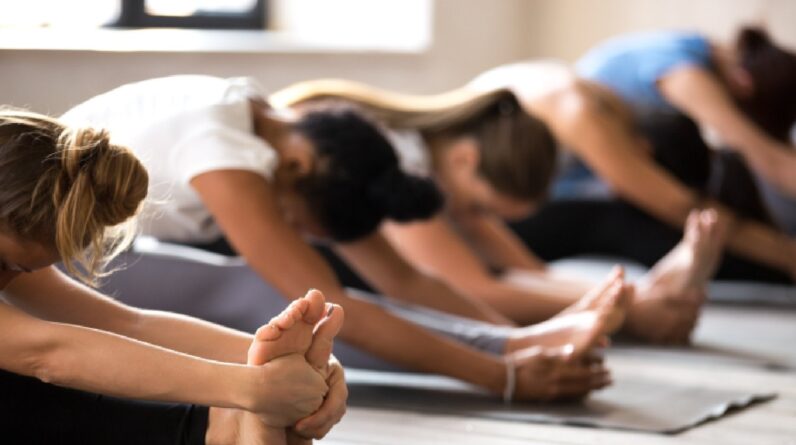
Do you get puffy eyes from staring at screens all day? Fret not! Here are some helpful yoga for puffy eyes and overall well-being.
Do you regularly wake up with swelling beneath your eyes, wondering if it means anything bad for your health? While puffy eyes can be caused by many factors such as water retention, dehydration, certain allergies, or ageing, the problem could also simply indicate that you have been putting your eyes under too much strain and not resting them enough. Although it can be irritating, yoga may offer an unexpected remedy for puffy eyes. Yoga for puffy eyes can assist in minimising puffiness and improve overall eye health. While not a cure-all, it can be a refreshing and natural method to boost your appearance.
What are puffy eyes?
Puffy eyes occur due to fluid accumulation in the tissues surrounding your eyes. This thin under-eye region has minimal connective tissue, making puffiness noticeable. Puffy eyes can be caused due to various factors such as lack of sleep or poor sleep quality, allergies or sinus problems, excessive salt intake leading to fluid retention, dehydration, eye strain from excessive screen time, and ageing which can lead to weakened muscles around the eyes, says yoga expert Himalayan Siddhaa Akshar.
7 natural ways to get rid of those ugly dark circles

How do yoga poses reduce puffy eyes?
Yoga poses can help reduce puffy eyes in several ways, including:
1. Improves blood circulation
Regular practice of yoga helps to improve blood circulation and overall well-being, as found in a study published in the International Journal of Yoga. Certain yoga poses can increase blood flow to the face, including the area around the eyes. This can help flush out any stagnant fluid that might be contributing to puffiness. However, more research is needed to prove the claim.
Also Read

2. Decreasing stress
Regular practice of yoga can help you manage stress and anxiety, as found in a study published in the Journal of Ayurveda and Integrative Medicine. Many yoga poses and breathing techniques reduce stress, which can contribute to reducing puffy eyes. However, more research is needed to prove the claim.
3. Stimulating lymphatic drainage
The lymphatic system is responsible for removing waste products and excess fluid from the body, as found in a study published in the Cold Spring Harbor Perspective in Medicine Journal. Some yoga poses might gently stimulate this system, promoting better drainage around the eyes and reducing puffiness. However, more research is needed to prove the claim.
Best yoga poses for puffy eyes
Here are some best yoga poses for reducing puffiness under the eyes, as explained by the expert:
1. Seated forward bend or Paschimottanasana
Paschimottanasana is known for its calming and soothing effects on the neurological system. The forward bending motion helps to relieve tension in the back, neck, and shoulders, lowering stress and anxiety. The pose also promotes deep breathing, which enhances relaxation. This pose also helps improve blood circulation to the face and eyes, which helps to reduce puffiness, as found in a study published in the International Journal of Science and Research.
How to do:
- Sit on a mat with your legs extended in front of you.
- Inhale slowly while raising arms overhead.
- Exhale slowly and gradually start bending forward from the hips, reaching for your feet.
- Hold for 5-10 deep and slow breathing.
2. Downward facing dog pose or adho mukha svanasana
“Practising a downward-facing dog pose gives instant stress-busting effects. Long-term stress can cause weight gain, dark circles, puffy eyes, acne, pigmentation, and a patchy complexion,” explains the expert:
How to do:
- To begin a downward-facing dog, start on your hands and knees in a tabletop position.
- Simply press your toes into the floor, elevate your pelvis, and straighten your knees.
- Straighten your arms and softly stare at your navel, maintaining your head between your arms.
- Hold for 5-10 breaths, focusing on deep inhalations and exhalations.
3. Child’s pose or balasana
You can perform balasana after a long day at work or a rigorous workout. It might assist in relaxing and calming your muscles, ensuring a good night’s sleep which indirectly helps to reduce puffiness. However, more research is needed to prove the claim.
How to do:
- Kneel on the floor or mat, and sit back on your heels.
- Extend your arms forward, resting your forehead on the ground.
- Hold for 5-10 deep breaths.
4. Fish pose or matsyasana
Fish pose is an effective way to reduce stress and anxiety, which can be a major reason for puffy eyes. It also helps to improve cardiovascular health, as found in a study published in the International Journal of Yoga.
How to do:
- Lie on your back on the mat or floor, slowly lift your chest, and place the crown of your head on the floor or mat.
- Keep your lower back pressed into the ground.
- Hold for 5-7 breaths, focusing on deep chest breathing.
5. Legs-up-the-wall pose or viparita karani
The legs-up-the-wall pose helps drain fluid from the face and eyes and can minimise inflammation. It reduces the effects of causes that can lead to puffy eyes and dark circles, as found in a study published in the Psychosom Medicine Journal.
How to do:
- Lie on your back on the mat or floor with your legs extended up a wall.
- Keep your arms relaxed by your sides.
- Hold for 5-10 minutes, breathe deeply and slowly.

6. Alternate nostril breathing or anulom vilom
Alternate nostril breathing or anulom vilom helps to balance the nervous system and reduce stress. This indirectly helps to reduce the puffiness of the eyes. However, more research is needed to prove the claim.
How to do:
- Sit comfortably with a straight spine.
- Use your right thumb to close your right nostril, and inhale through the left.
- Close the left nostril with your ring finger, and exhale through the right.
- Inhale through the right, then exhale through the left.
- Continue this pattern for 5-10 minutes.
Who should avoid these yoga poses to reduce puffy eyes?
- While yoga is generally safe, some individuals should avoid or modify certain poses:
- People with high blood pressure should avoid inverted poses.
- Those with neck or back injuries should be cautious with forward bends and fish pose.
- Pregnant women should avoid lying on their backs for extended periods.
- Individuals with glaucoma should avoid inverted poses.
- Those with recent eye surgeries should consult their doctor before practising yoga.
Always consult a healthcare professional or a qualified yoga instructor if you have any medical concerns or conditions.







